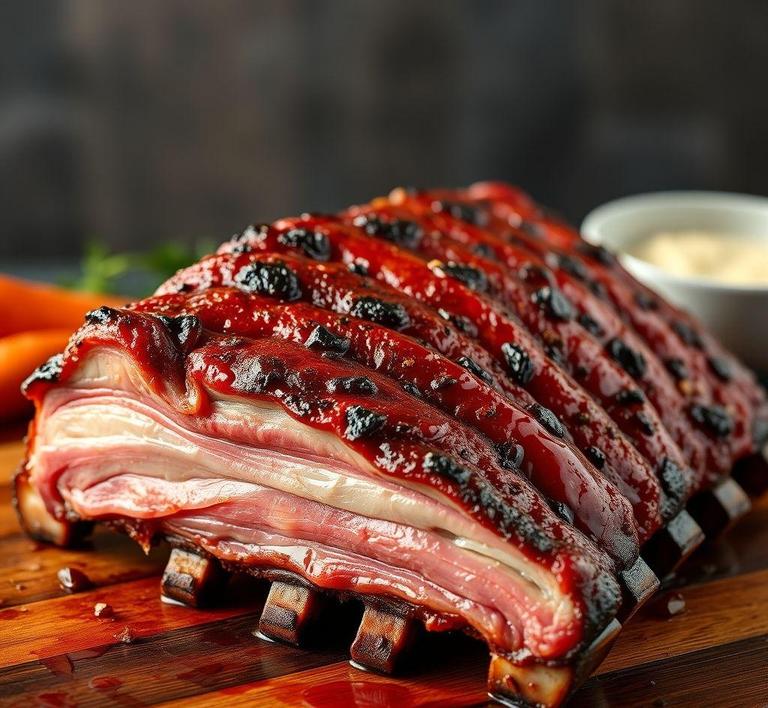If you’ve found yourself with leftover pork baby back ribs and aren’t sure what to do with them, refreezing them can be a great option to enjoy later without losing flavor or texture. Refreezing these tender, smoky ribs can preserve their juiciness and make for an easy meal when you’re craving something delicious but don’t want to cook from scratch. But before you toss them back in the freezer, there are a few steps to follow to ensure that your ribs stay as tasty as possible when reheated. In this guide, we’ll walk you through the right way to refreeze your pork baby back ribs so you can enjoy them at their best whenever you’re ready!
Can You Refreeze Pork Baby Back Ribs?

Yes, you can refreeze pork baby back ribs-under certain conditions. The decision to refreeze meat hinges on one key factor: whether it was thawed safely. If you initially thawed your pork ribs in the refrigerator and kept them at or below 40°F (4°C), it is safe to refreeze them. However, if the ribs were thawed at room temperature, such as on a kitchen counter, or were left in the "danger zone" (40°F-140°F) for more than two hours, they should not be refrozen due to the risk of bacterial growth.
This safety threshold is crucial because pork, like all meats, is highly perishable and vulnerable to pathogens like Salmonella and E. coli. These bacteria can multiply rapidly when meat is kept in unsafe temperature ranges, even if the ribs still appear and smell fine. Therefore, the rule of thumb is this: if the ribs were defrosted slowly and properly in the fridge, and have not been cooked or left out too long, they can be returned to the freezer.
How To Refreeze Pork Baby Back Ribs?
Refreezing pork baby back ribs is a straightforward process, but there are several important steps you should follow to preserve both safety and quality:
-
Check the Thawing Method:
- Ensure the ribs were thawed in the refrigerator. If they were thawed in cold water or a microwave, they must be cooked before refreezing.
- Never refreeze meat that was thawed at room temperature.
-
Inspect the Ribs:
- Look for any signs of spoilage such as off odors, sliminess, or discoloration.
- If in doubt, throw it out. It’s not worth the risk.
-
Wrap Properly:
- Rewrap the ribs tightly in freezer-safe packaging. Use heavy-duty aluminum foil, vacuum-seal bags, or plastic wrap followed by a freezer bag to prevent freezer burn.
- Remove as much air as possible from the packaging.
-
Label the Package:
- Clearly write the date of refreezing and the contents. This helps you keep track of how long they’ve been frozen and ensures you use older items first.
-
Freeze Promptly:
- Return the ribs to the coldest part of your freezer (ideally 0°F/-18°C or lower).
- Avoid opening the freezer frequently during the initial hours after refreezing, so the temperature remains stable.
Quality Impact
While it’s safe to refreeze pork baby back ribs that were thawed properly, the process can affect the meat’s texture, flavor, and moisture retention. This is because each freeze-thaw cycle breaks down muscle fibers and causes water loss.
Here’s how the quality might be affected:
- Texture: The ribs may become slightly mushier after refreezing and thawing again. The ice crystals formed during freezing can puncture the muscle cells, making the meat less firm.
- Juiciness: A second freezing often leads to more liquid loss during cooking. The ribs might be drier compared to fresh or once-frozen meat.
- Flavor: Although flavor degradation is minimal if the ribs are well-wrapped and not stored for too long, some subtle changes might occur, particularly in ribs that were seasoned or marinated before freezing.
- Appearance: You may notice some discoloration or freezer burn if the ribs weren’t properly wrapped. Freezer burn doesn’t make the ribs unsafe to eat, but it can lead to tough, leathery spots and off flavors.
To minimize quality loss, try to refreeze the ribs only once, use them within 1-2 months of refreezing, and cook them with moist-heat methods like braising or slow-roasting to restore tenderness.
Refreezing pork baby back ribs is both possible and safe, provided you’ve handled the meat correctly during thawing. The key is temperature control-refrigerator thawing is your green light, while countertop thawing is a red flag. Though repeated freezing can impact the ribs’ texture and moisture content, proper wrapping and timely use can help retain their quality. So, whether you’ve overestimated your BBQ plans or just want to store leftovers for another day, with careful handling, your ribs can make a triumphant return to the freezer and, eventually, your plate.
Is It Safe To Refreeze Pork Baby Back Ribs?
Yes, it can be safe to refreeze pork baby back ribs-but only under the right conditions. The most critical factor in determining safety is the ribs’ temperature history. If the ribs were thawed in the refrigerator and have not exceeded 40°F (4°C) for more than two hours, then it is generally safe to refreeze them.
The USDA confirms that meat thawed in the fridge can be refrozen without cooking, although there may be some loss in quality. When refrozen, the meat’s moisture content can diminish, potentially leading to drier, tougher ribs upon cooking. However, from a food safety perspective, this method is acceptable.
However, ribs thawed at room temperature, in warm water, or in the microwave should not be refrozen unless they’ve been cooked first. These faster methods of thawing bring parts of the meat into the temperature "danger zone" (40°F to 140°F), where bacteria multiply rapidly.
Signs That Pork Baby Back Ribs Should Not Be Refrozen
Before refreezing, it’s vital to inspect your pork ribs for any signs of spoilage. Freezing does not kill bacteria; it only slows their growth. Refreezing spoiled meat can be hazardous. Watch for these warning signs:
- Off-putting odor: A sour, sulfuric, or ammonia-like smell indicates bacterial breakdown. Even subtle foul odors are red flags.
- Slimy texture: A sticky, tacky surface film is often a result of bacterial growth.
- Discoloration: While some color change is natural due to oxidation, any greenish, grey, or dull brown hues should be approached with caution.
- Ice crystals and freezer burn: If you’re considering refreezing thawed ribs that already have extensive freezer burn or ice crystals, quality is significantly compromised and further freezing will only worsen the texture and taste.
Remember, when in doubt, throw it out. Spoiled meat can harbor dangerous pathogens like Salmonella, Listeria, and E. coli-even if it looks or smells only mildly off.
Common Refreezing Mistakes
Refreezing meat is a delicate practice, and unfortunately, many home cooks make preventable mistakes. Here are a few common ones:
-
❌ Refreezing After Room Temperature Thawing
Leaving ribs out on the counter for hours to thaw is unsafe. This can expose meat to bacterial growth even before you attempt to freeze it again.
-
❌ Repeated Freezing and Thawing Cycles
Each cycle breaks down cell walls and drains moisture, leading to flavorless, mushy ribs. Limit to one refreeze if possible.
-
❌ Refreezing Meat Past Its Prime
If your ribs were already approaching their use-by date when first frozen or thawed, don’t refreeze. The quality and safety are already compromised.
-
❌ Improper Storage
If your ribs were not stored in airtight packaging, they might suffer freezer burn or cross-contamination. Always use freezer-safe, vacuum-sealed bags or heavy-duty foil.
-
❌ Ignoring the Refrigerator Thawing Rule
Only pork that was thawed in the refrigerator should be considered for refreezing without cooking.
🧠 Tips And Tricks For Safe And Flavorful Refreezing
Now that you know what not to do, here are some expert-approved tips to make the most of your pork ribs and keep them safe and delicious:
- 🕰 Label with Dates: Always mark the original freezing date and the date of refreezing. Pork ribs are best used within 4-6 months for peak quality, but refrozen ribs should ideally be consumed within a month or two.
- 🌬 Vacuum Seal for Best Results: Use a vacuum sealer or remove as much air as possible to prevent freezer burn and preserve flavor.
- ❄️ Freeze in Portions: Divide ribs into meal-sized portions so you only thaw what you need, avoiding the temptation to refreeze leftovers.
- 🌡 Use a Thermometer: Keep your freezer at or below 0°F (-18°C). This ensures that food remains safely frozen, and any refrozen meat stays viable.
- 🍽 Cook Before Refreezing (Optional): If you’ve already thawed your ribs but are unsure about refreezing raw meat, cook them thoroughly, let them cool, and then freeze. This halts bacterial growth and allows for a longer freezer life.
Conclusion
Refreezing pork baby back ribs is not inherently dangerous, but it hinges entirely on how the ribs were thawed and handled. By observing strict food safety practices-keeping meat at safe temperatures, watching for signs of spoilage, avoiding repeated freeze-thaw cycles, and using quality packaging-you can safely refreeze your ribs with minimal quality loss.
While it’s best to plan meals in a way that avoids the need to refreeze meat, life happens. Armed with knowledge and attention to detail, you can confidently preserve your delicious baby back ribs for future enjoyment.
Whether you’re prepping for a backyard BBQ or stocking up after a great grocery deal, food safety is just as important as flavor. With these guidelines, you’re equipped to do both right.


